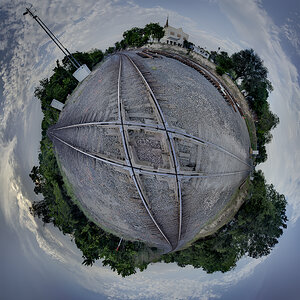Moglex
TPF Noob!
- Joined
- Jun 13, 2008
- Messages
- 581
- Reaction score
- 0
- Location
- Whitstable
- Can others edit my Photos
- Photos OK to edit
Indeed, we can be reasonably certain that some printers interpolate.1) Printers can, and do, interpolate.
Oh, I'm afraid that is far from the case.2) What happened a quarter of a century ago is no longer relevant.
Decisions made during the design of architectures can and do have consequences for incredible lengths of time after the reasons for those decisions have slipped into history.
You have to remember that todays chips are around 1,000-4,000 times more powerful than those around when these GUI's were developed. Machines tend to have 16,000 times the memory.
Hard disks are up to 200,000 times larger.
The hard disk on one of those early cameras couldn't even hold an uncompressed image from a modern 35mm camera, now you can store several in memory.
These constraints framed the way elements of the GUI were designed.
Indeed, but the fundamental software model of the GUI hasn't.3) Things change.
Changes happen,
A statement of the blindingly obvious, if I may say so!
such as device dependent journal files (that are resolution dependent) being replaced by EMF and EMF+ files that are not device dependent, and that carry more information than a simple bitmap.
Indeed. However, these are vector graphic files and as such are not relevant to dealing with bitmapped images.
I am still waiting, by the way, for backup for your statement that there are other ways for programs such as PSP and PS to print rather than the methods using bitmaps that are to be found in the Windows reference material.
Unless and until you can provide such backup there is still no demonstrated path for PSP/PS to send information to the PAD (printer and driver) in such a way that the PAD would know to expand it.
By the way, I wrote 'may be laughable'. The point of the sentence was to suggest that printer drivers can interpolate.
But as I pointed out, the statement is incorrect, here in 2008.


![[No title]](/data/xfmg/thumbnail/30/30862-d177ccfc3a82369b1005863cfe5fd13d.jpg?1619734481)

![[No title]](/data/xfmg/thumbnail/30/30860-944669dcf33f1f20df14586c78ed2608.jpg?1619734480)
![[No title]](/data/xfmg/thumbnail/36/36643-92fe0dd9e247722bfefe299cd8a549f5.jpg?1619737670)

![[No title]](/data/xfmg/thumbnail/30/30864-50861ef77d7fa163bd5f5b5b8d661f5a.jpg?1619734483)
